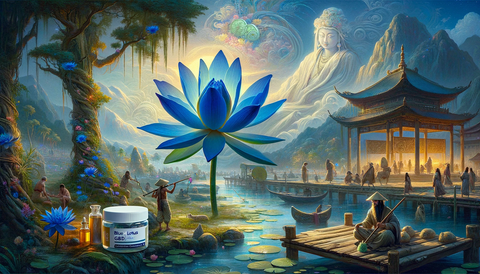
What Are Blue Lotus Gummies?
Share
Blue lotus gummies have emerged as a popular trend, marketed for relaxation and well-being. This outline explores what these gummies are, delving into their ingredients, potential benefits and risks, and legal considerations.

Composition of Blue Lotus Gummies
Blue Lotus Extract: A Deeper Dive
Inclusion: Blue lotus extract is the primary active ingredient in blue lotus gummies, typically derived from the dried flowers or leaves of the Nymphaea caerulea plant. Manufacturers utilize various extraction methods, including water or alcohol, to concentrate the purportedly beneficial compounds.
Intended Benefits: Blue lotus extract is marketed for a range of potential benefits, though it's important to emphasize the lack of substantial scientific evidence to support these claims:
- Relaxation and Stress Reduction: Proponents claim blue lotus extract possesses calming properties that may ease anxiety and promote relaxation. This effect is often attributed to the presence of alkaloids like nuciferine, which may interact with neurotransmitters in the brain, potentially influencing mood and stress response.
- Improved Sleep: Blue lotus extract is sometimes touted as a natural sleep aid, with claims suggesting it can promote better sleep quality and reduce sleep disturbances. However, concrete evidence is lacking, and the potential effects on sleep regulation remain unclear.
- Enhanced Mood: Some users report experiencing mood elevation and general well-being after consuming blue lotus extract. The proposed mechanism for this effect is not fully understood, but it might be related to the potential influence of alkaloids on the brain's reward system.
- Aphrodisiac Properties: Historically, blue lotus has been associated with aphrodisiac qualities, and some modern claims suggest the extract might enhance libido or sexual function. However, scientific research in this area is virtually absent, and any potential aphrodisiac effects are purely anecdotal and lack credible supporting evidence.
Dosage Considerations: It's crucial to note that the amount of blue lotus extract present in gummies can vary significantly between brands. This variation makes it difficult to establish a standardized dosage, and potential effects can be unpredictable. Additionally, the lack of long-term safety studies on blue lotus extract consumption raises concerns, especially for individuals with pre-existing health conditions or those taking medications.
Additional Ingredients
Beyond the blue lotus extract, several other ingredients are commonly found in blue lotus gummies, each potentially influencing their effects:
- Cannabidiol (CBD): This non-intoxicating compound derived from the hemp plant is often added for its potential benefits like reducing anxiety, improving sleep, and alleviating pain. However, it's crucial to note that the legality and regulations surrounding CBD vary by region, and its interaction with blue lotus is not fully understood.
- Cannabinol (CBN): Another cannabinoid, CBN, is known for its potential sleep-inducing properties. Its inclusion in blue lotus gummies might be intended to enhance their relaxation effects, but research on its specific effects and interactions with other ingredients is ongoing.
- Melatonin: This naturally occurring hormone regulates the sleep-wake cycle. Some blue lotus gummies may contain melatonin to further promote relaxation and sleep. However, melatonin can have side effects like drowsiness and should be used cautiously, especially by individuals taking certain medications.
- Flavorings and Sweeteners: Various flavorings and sweeteners are added to enhance the palatability of the gummies. While generally safe for consumption, individuals with allergies or sensitivities should check the ingredient list carefully.
Dosage Variations:
The potency of blue lotus gummies varies significantly across brands, making it crucial to be cautious and informed before consuming them. Here's a breakdown of factors contributing to the variations:
- Blue Lotus Extract Concentration: The amount of blue lotus extract per gummy can differ considerably. Some brands might use a lower concentration, focusing on other ingredients for their effects, while others might offer higher concentrations targeted towards experienced users.
- Presence and Concentration of Additional Ingredients: The inclusion and varying amounts of CBD, CBN, melatonin, and other ingredients significantly impact the overall potency and potential effects of the gummies.
- Manufacturing Processes: Different extraction and manufacturing processes can influence the final alkaloid content and potential psychoactive effects of the blue lotus extract used in the gummies.
Due to these variations, it's essential to carefully read the label and dosage instructions provided by each brand. Additionally, consulting a healthcare professional before consuming blue lotus gummies is highly recommended, especially for individuals with underlying health conditions or taking medications, as potential interactions and side effects are not fully established.
Overall, while blue lotus extract holds historical significance and potential benefits are often suggested, the current scientific understanding of its effectiveness and safety profile remains limited. Further research is necessary to definitively determine the true effects of blue lotus extract, and responsible consumers should exercise caution and consult healthcare professionals before incorporating blue lotus gummies into their routine.

Unveiling the Blue Lotus
Historical Significance: A Deep Dive into the Blue Lotus Flower's Ancient Use
The blue lotus flower, also known as the Egyptian lotus or Nymphaea caerulea, boasts a rich history deeply intertwined with various ancient cultures. Exploring its past uses provides valuable context for understanding its modern-day resurgence in the form of blue lotus gummies.
Egypt:
- Religious Symbolism: In ancient Egypt, the blue lotus held immense religious significance. Its vibrant blue hue symbolized the sun god Ra, representing creation, rebirth, and eternal life. It frequently adorned pharaohs and deities in artwork, ceremonies, and even funerary practices.
- Medicinal Applications: Egyptians believed the blue lotus possessed healing properties. Texts record its use for various ailments, including anxiety, fevers, and digestive issues. The flower was also applied topically to treat wounds and skin conditions.
- Ritualistic Use: The blue lotus played a central role in religious rituals and offerings. Egyptians believed it facilitated communication with the gods and enhanced spiritual experiences. They incorporated the flower into sacred ceremonies, consumed it in beverages, and even placed it in tombs.
India:
- Spiritual Significance: In Hinduism and Buddhism, the blue lotus flower symbolizes purity, enlightenment, and spiritual growth. It is often depicted with deities like Buddha and Lakshmi, representing their connection to the divine realm.
- Symbolic Representation: The lotus flower's characteristic ability to rise above muddy water represents the human spirit's ability to overcome challenges and attain enlightenment. This symbolism permeates various aspects of Indian culture, including art, literature, and religious practices.
- Ayurvedic Medicine: Similar to Egypt, ancient Ayurvedic medicine in India utilized the blue lotus for its purported calming and therapeutic effects. It was used for various ailments, including insomnia, anxiety, and heart conditions.
Beyond Egypt and India:
- Other Ancient Cultures: The blue lotus flower also held significance in other ancient civilizations, including Assyria, Greece, and China. Each culture attributed different symbolic meanings and uses to the flower, highlighting its widespread influence throughout history.
Botanical Classification of the Blue Lotus
Family and Genus: The blue lotus flower belongs to the Nymphaeaceae family, commonly known as the water lily family. This family encompasses various aquatic flowering plants known for their beauty and diverse adaptations to their wetland habitats. Within the Nymphaeaceae family, the blue lotus falls under the genus Nymphaea, which includes a large group of water lilies characterized by their showy flowers and rhizomatous root systems.
Species and Subspecies: The specific blue lotus flower associated with potential psychoactive properties is Nymphaea caerulea. It's important to note that other Nymphaea species exist, and not all possess the same chemical composition or potential effects as N. caerulea. Within N. caerulea, there are further sub-classifications, with Nymphaea caerulea var. azurea being the most commonly encountered variety used in herbal products like gummies.
Key Characteristics: N. caerulea is a perennial aquatic plant native to tropical and subtropical regions of Africa, Asia, and Australia. It features beautiful blue flowers with numerous petals, typically blooming during the day and closing at night. The plant thrives in still or slow-moving freshwater environments, with its roots anchoring in the bottom sediment while the leaves and flowers float on the water surface.
Psychoactive Properties of the Blue Lotus
Presence of Alkaloids: N. caerulea contains various alkaloids, which are naturally occurring nitrogenous compounds with diverse pharmacological properties. Two key alkaloids in the blue lotus are nuciferine and apomorphine.
1.3.5 Potential Effects: These alkaloids are believed to contribute to the potential psychoactive effects of the blue lotus. Nuciferine might exhibit antidepressant, anti-anxiety, and sedative properties, while apomorphine, in higher doses, can induce dopamine receptor activation, potentially leading to feelings of euphoria and increased energy. However, it's crucial to emphasize that research on the precise effects and mechanisms of action of these alkaloids in humans is limited.
Dosage and Variability: The potential psychoactive effects of the blue lotus are further complicated by the variability in alkaloid content across different plant parts and the processing methods used to extract them for inclusion in gummies. This variability makes it difficult to establish consistent or predictable effects across different products or even batches within the same brand.
It's important to remember that the information above is purely for educational purposes and should not be interpreted as medical advice. Always consult with a qualified healthcare professional before consuming any product containing blue lotus or other potentially psychoactive substances.
By understanding the historical significance of the blue lotus flower, we gain a deeper appreciation for its cultural and spiritual significance. However, it is crucial to acknowledge the lack of scientific evidence supporting many of its historical uses. While the historical context adds a layer of intrigue, it's vital to critically evaluate contemporary claims surrounding the blue lotus, particularly in the context of modern-day blue lotus gummies.
Conclusion
Blue lotus gummies remain a recent trend with limited scientific backing for their claimed benefits. While the historical and cultural significance of the blue lotus flower is noteworthy, its safety and efficacy in gummy form require further research. Consulting a healthcare professional before consuming these gummies is crucial, especially for individuals with underlying health conditions or taking medications.

